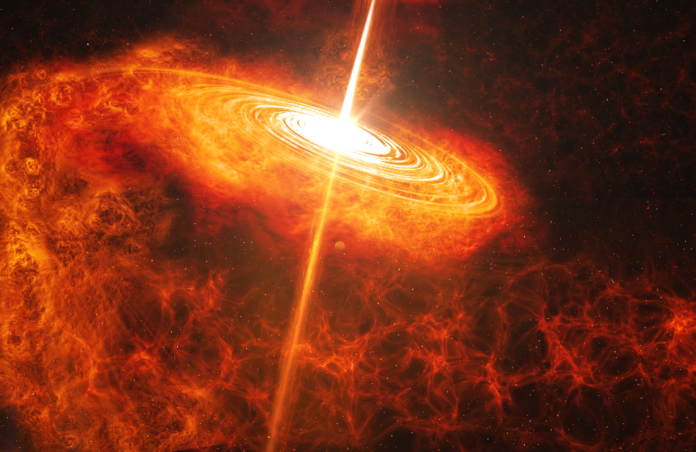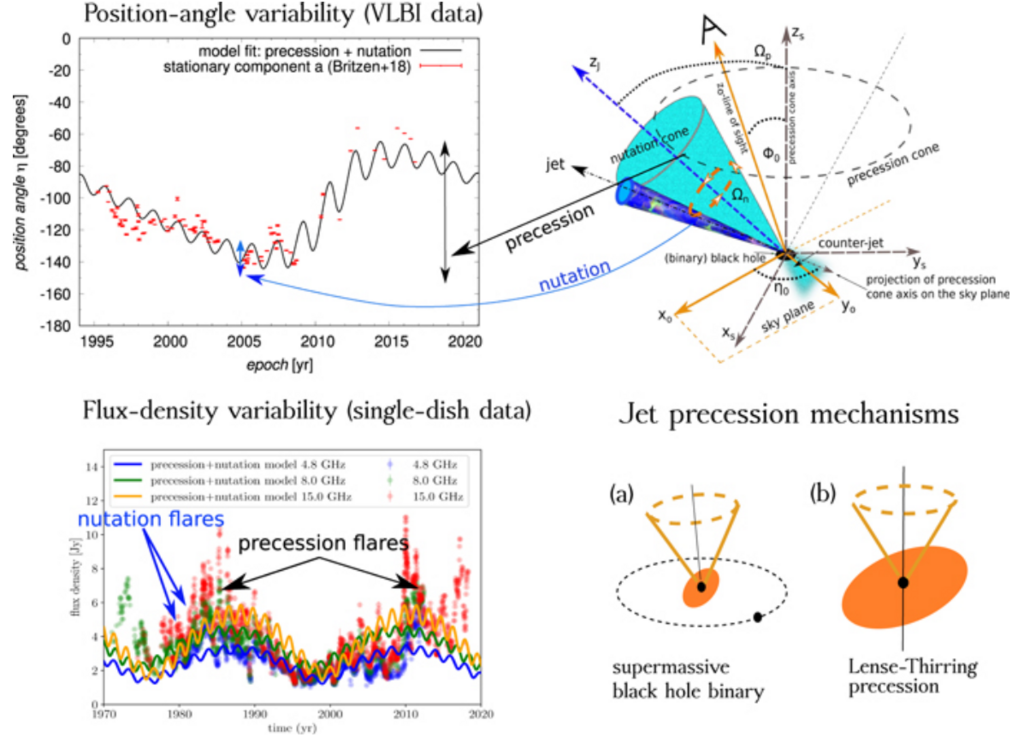Precessional Effects of AGNs on their Variability

Active Galactic Nuclei (AGNs) represent some of the most energetic phenomena in the cosmos. Their understanding is pivotal for astronomers, as they shed light on the dynamics at play in distant galaxies. At their core, supermassive black holes drive massive outflows, forming bright jets that emit radiation across a wide spectrum. Among these, Blasars stand out as a unique subclass of AGNs, characterized by emission jets that are directly aligned with an observer on Earth.
Since the late 1970s, astronomers have observed that AGNs showcase variability over time, particularly evident at low, radio wavelengths. Historically, these ‘flares’ were believed to arise from stochastic factors. One prevalent model describes shocks within the ejecta resulting from the collision of regions with different velocities. Another theory suggests that these flares could be the result of sudden ejections of matter from the core, radiating brightly through a mechanism known as synchrotron radiation.
In their recent study, Britzen et al. challenge these models, suggesting that the variability phenomenon could be attributed to the precession and nutation of the AGN system. This contrasts with previous explanations that leaned towards a stochastic understanding. Leveraging prior publications, Britzen modelled the extent to which precession might influence the observed flux of an AGN. Their focus centred on OJ 287, a notable candidate for an AGN binary system. Utilizing data from the GMVA and ALMA telescopes, the team engaged in Very Long Baseline Interferometry (VLBI), a technique employed to achieve ultra-high-resolution images.

Crucially, the high resolution of their data set allowed them to derive accurate structural information of the AGN. This allowed them to differentiate between sources of variability and attribute the structure of their light curves to different mechanisms. While they recognized the roles of the previously mentioned models, they noted such mechanisms would account for short-term variabilities, typically less than 0.2 years. Instead, they claim that their precession models more aptly describe the variability of the AGN on a much larger temporal scale, exceeding one year.
The structural insights revealed that the effect of precession on variability is deeply rooted in the AGN's ejection jets, which emanate from the black hole's poles. The precession causes the ejection direction to vary, tracing a conical path. Consequently, this makes the jet adopt a curved form, as observed in OJ 287.
Diving deeper into the reasons behind precession and nutation, Britzen et al. speculate that an asymmetric accretion disk around the black hole could be a factor. However, a more compelling theory suggests the gravitational effects of a binary black hole system. This innovative approach potentially offers a more efficient method to identify such binary systems in the universe.
Britzen et al.'s deterministic model, rooted in the precession and nutation of the relativistic jet, paves the way for fresh perspectives on AGN variability. Their conclusions resonate with broader cosmic theories, like the hierarchical evolution involving galactic mergers. Moreover, the potential influence of binary black hole systems on AGN behaviours emerges as a profound revelation. By testing their model on twelve other AGNs, they bolster the idea that precessional effects are not mere anomalies but could be a widespread phenomenon in the AGN landscape.
--
Journal Source: S. Britzen et al, Precession-induced Variability in AGN Jets and OJ 28, The Astrophysical Journal, Vol. 951, No. 2, 2023, https://doi.org/10.3847/1538-4357/accbbc
Cover Image: DeviantArt, Archange1Michael
